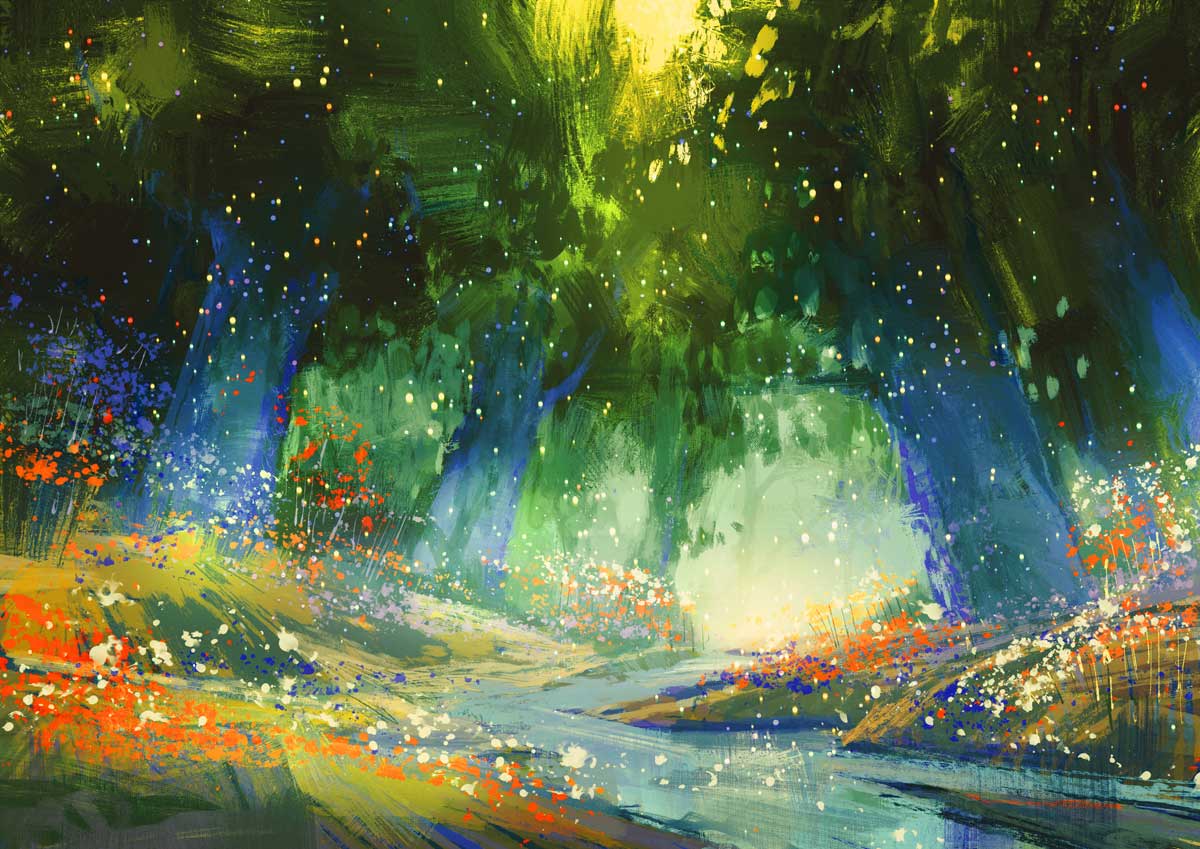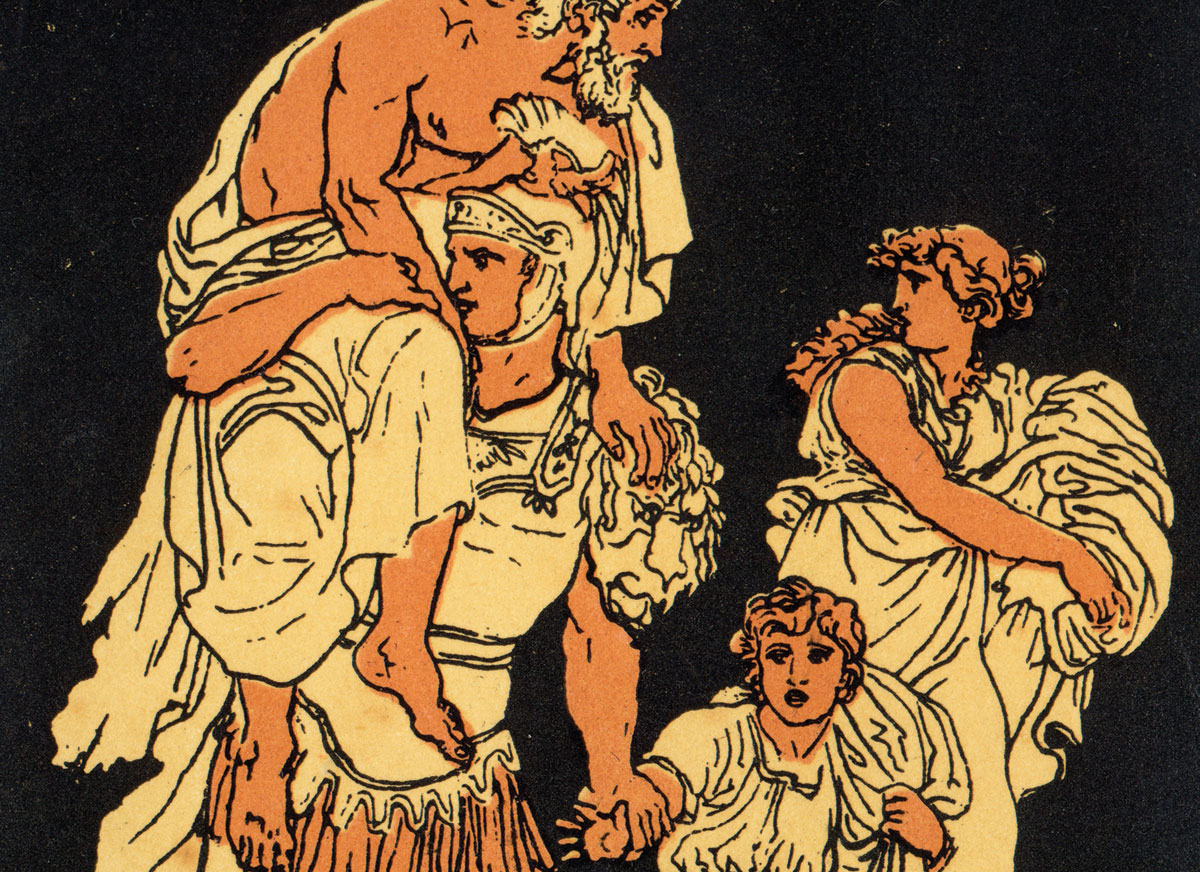Feature
Of Weeds & Fairy Tales
The Idylls, Idols & Devils That Corrupt the Moral Imagination
I am a gardener, and the good essay on gardening pays attention to the characteristics and habits of weeds. This is an essay on the moral imagination, and so I must pay attention to some of the worst and most unholy forms of imagination, forms that spread like the weeds in an ill-kept flower garden and choke out the best cultivars.
Too many people naively associate the imagination solely or even primarily with what is moral and good. Keats went too far when he rhapsodized: “I am certain of nothing but the holiness of the heart’s affections and the truth of imagination—what the imagination seizes as beauty must be truth.” The human heart’s desires may not be holy and the imagination born of these unholy desires may even be demonic. After all, it was the tyrant Napoleon who hauntingly declared, “Imagination rules the world.”
The Book of Proverbs declares, “Where there is no vision, the people perish.” Where there is no real moral imagination, itself a form of vision, the people will become captives of corrupt and corrupting imaginations, for while imagination as such may be an innate human capacity, it needs proper nurture and cultivation. If the tea rose is not properly attended, it withers, and the thistle grows in its place. If the moral imagination is not fed by religious sentiment and supported by reason, it will wither and be replaced by the corrupt forms of imagination.
Thus, I need to name and describe three forms of imagination that flourish in the ill-kept garden of our society, weeds that are crowding out the flowering of the moral imagination. These I am calling the idyllic imagination, the idolatrous imagination, and the diabolic imagination.
Stories We Live By
Our society is failing to cultivate the moral imagination in part at least because very often the stories we live by—the stories we read ourselves or read to our children, the stories we watch on television or at the movies—are not stories that grow the moral imagination, but stories that crowd it out. Others have testified to the lively manner in which the traditional myths and fairy tales feed and nurture the moral imagination, especially in the young—but not exclusively the young, for they were invented for the entertainment and edification of adults.
Imagination illuminates reason, gives it sight and insight. In Enemies of the Permanent Things, Russell Kirk reminded us that “the story of Pandora, or Thor’s adventure with the old woman and her cat, gives any child insight into the conditions of existence, dimly grasped at the moment, perhaps, but gaining in power as the years pass, that no utilitarian ‘real life situation’ fiction can match.” Through “the wisdom latent in traditional fantasy” the child learns early in life “that valid if complex means of normative judgment [are] produced by the conjunction of a great variety of little proofs, illustrations, and inferences.”
The telling and reading of such stories is “a natural activity,” J. R. R. Tolkien noted in his famous essay “On Fairy-Stories.”
It certainly does not destroy or even insult Reason; and it does not either blunt the appetite for, nor obscure the perception of, scientific verity. . . . For creative fantasy is founded upon the hard recognition that things are so in the world as it appears under the sun, on the recognition of fact, but not slavery to it. . . . If men could not distinguish between frogs and men, fairy-tales about frog-kings would not arise. (my emphasis)
Children find frog-princes interesting because reason tells them they are incomplete, not entirely whole. They are attracted to the story of “The Ugly Duckling” or “The Little Lame Prince” because reason tells them, based upon simple observation, that they are in some sense ugly or lame with respect to adults. When they long for the day when they are equal in strength and capacity to grown-ups, the imagination comes into its own.
Children want to explore just what it might be like to finally turn out “whole” and all right, to be a good child, a good parent, or the best of rulers. Pinocchio is the quintessential child. This yearning to be whole and wholly real attracts even adults to fairy kings and queens, to Prince Caspian in C. S. Lewis’s Narnia Chronicles or Princess Irene of George MacDonald’s The Princess and the Goblin, because reason and observation tell them that they are ugly, lame, and incomplete with respect to what they might be and were meant to be.
Such stories feed the moral imagination and finally the religious sense, and thus possess more power than has reason to move the will.
Imagination’s Purpose
But what are the imagination and the moral imagination in particular? At the start of the last century, Harvard professor Irving Babbitt wrote on the imagination in his memorable study Literature and the American College. The human imagination “reaches out and seizes likenesses and analogies” that establish relation and unity in a world of meaning. In other words, imagination is the self’s process of finding direction and purpose in life by making metaphors from remembered experiences to understand present experience. It is not an instinct but an attribute and an expression of our freedom, passion, and reason.
Some may think that the important question is whether imagination is waxing or waning in society. But this is not the issue. Wherever there are human beings, imagination exists and is exercised, much as wherever there are spiders, webs are spun. The important question is what kinds of imagination our contemporary culture encourages.
We do not worry that spiders might spin their webs badly or misuse them, because spiders spin their webs from instinct, but human beings exercise their imagination freely. Imagination both expresses and trains the reason and the will. Indeed, it is perfectly correct to say that man is every bit as much an imaginative creature as a reasoning one or one that possesses a free will.
I do not doubt that imagination is right at the source of what theologians speak of as the image and likeness of God in man. The philosopher George Santayana, a contemporary of Babbitt’s, justly maintained that the distinction we often make between “intelligence (or reason) and imagination is ideal” and ultimately not sustainable. This distinction, he argued, derives from our need to locate within ourselves a power and source of authority that will validate our deeply seated yearnings for a unified and meaningful life, what he called “spiritual life.”
Yet reason, which serves so well for solving the so-called factual problems and theoretical issues of living, cannot on its own project the vision that infuses meaning and purpose into life. “The eye sees what it has been given to see by concrete circumstance,” wrote Flannery O’Connor, but “the imagination reproduces what, by some related gift, it is able to make live.”
Life is a dynamic process in which reason and imagination are integrated. Thought based solely in sense demands empirical verification and is unable to attain “satisfying or satisfactory conclusions about the spiritual origins” or ends of human life, said Santayana in Poetry and Religion. This is where imagination comes in. For imagination furnishes and supplies to religion and morality “those larger ideas” and images which human beings need in order to envision an encompassing meaning and purpose for their lives.
Santayana continued: “Perceptions do not remain in the mind, as would be suggested by the trite simile of the seal and the wax, passive and changeless,” as it were, “until we wear off their sharp edges and . . . [they] fade.” Rather, “perceptions fall into the brain . . . as seeds into a furrow or even as sparks into a keg of powder.” Each image, in turn, gives birth to more images, “sometimes slowly and subterraneously, sometimes (when a passionate train is started) with a sudden burst of fancy.” This, Santayana maintained, is the genesis of imagination, as its images become resources of reason and inspirations to action.
The Moral Imagination
If that is the imagination, what is the moral imagination? The eighteenth-century British statesman Edmund Burke first coined the term in his great work Reflections on the Revolution in France. Lamenting the ferocity and rapidity with which the French revolutionists were destroying the customs and traditional institutions that preserve civility in society, he exclaimed:
But now all is to be changed. All the pleasing illusions, which made power gentle, and obedience liberal, which harmonized the different shades of life, and which, by bland assimilation, incorporated into politics the sentiments which beautify and soften private society, are to be dissolved by this new conquering empire of light and reason. All the decent drapery of life is to be rudely torn off. All of the superadded ideas, furnished from the wardrobe of a moral imagination, which the heart owns and the understanding ratifies, as necessary to cover the defects of our own naked shivering nature, and to raise it to dignity in our estimation, are to be exploded as ridiculous, absurd, and antiquated fashion.
The moral imagination is the distinctively human power to conceive of men and women as moral beings, i.e., as persons, not things or animals whose value to us is their usefulness. It is the process by which the self makes metaphors out of images recorded by the senses and stored in memory, which then are employed to find and suppose moral correspondences in experience.
The principal offices of life in which society invests and entrusts this care are parent and teacher. Modern educators—a breed with which I am all too familiar—have not been good gardeners of the moral life. In their penchant to treat fact as god, event as illusion, individual as datum, person as chimera, norm as relative value, and human nature as social construct, they leave the moral imagination to perish.
What grows in its place? I have mentioned three corrupted forms of imagination, the idyllic, the idolatrous, and the diabolic imaginations. As is the case with all corruptions, corrupted imagination betrays the integrity of the true form. In our everyday life, these corrupted forms manifest decomposition, not wholeness, and perversity, not normality.
The Idyllic Imagination
The first in the list is the idyllic imagination, named by Irving Babbitt and discussed by him in his books Democracy and Leadership and Rousseau and Romanticism. The idyllic imagination, he wrote, is fanciful without check, primitivist, and utopian. The self gripped by the idyllic imagination is escapist, not in the sense that it flees its physical surroundings so much as it shirks its civic, social, and moral responsibilities.
This is accompanied and reinforced by rejection and rebellion against old dogmas, manners, and mores. The idyllic imagination is in search of emancipation from conventional constraints. In our democratic and individualistic environment, persons justify this “liberation” in the name of self-fulfillment and self-realization, which they believe existing norms and structures inhibit or obstruct. Quite often there is a turning to hedonistic imaginings, flagrant sensuality, and explorations of the “flesh.” These are paths that promise happiness but more often than not lead instead to boredom and ennui or, worse, physical and spiritual dissipation.
This is much documented in clinical studies and in great modern literature such as Tolstoy’s Anna Karenina or Flaubert’s Madame Bovary. In Dostoevsky’s Crime and Punishment, Svidrigaylov, the middle-aged, dissipated debaucher, sums up this syndrome of the idyllic imagination shortly before he takes his own life. One evening in Raskolnikov’s tomblike one-room apartment, he explains to Raskolnikov how he is trapped in a pit of boredom and languor.
I’ll tell you frankly: I’m very bored. . . . Marfa Petrovna herself even suggested twice that I go abroad, seeing I was bored. But what for? I used to go abroad, and I always felt sick at heart. Nothing special, really—here’s the dawn coming up, here’s the Bay of Naples, the sea—you look, and it’s somehow sad. The most disgusting thing is that you are always sad about something! . . . I might go on an expedition to the North Pole now, because j’ai le vin mauvais, drinking disgusts me, and wine is the only thing I have left.
During the 1960s, when I came of age, the idyllic imagination flourished in the youth counterculture. It has taken a more troubling turn among college students today, in whom the idealism and utopianism of the sixties is much less present, whereas the disillusioning and dissipating symptoms of sensualism and anomie are played out in dormitories and bars.
The Idolatrous Imagination
The heavy footprints of the second in the trinity of corrupted imaginations may be tracked everywhere in our culture. The media fixes on false gods whose stories replace the lives of saints and real heroes. One need only look at the popular magazines, MTV, television talk shows, and celebrity channels, to understand how pervasive is the idolatrous imagination.
Even our schools and public libraries are heavily under its influence. I am not talking about movie videos or DVDs only. When I was a boy, books about great scientists, explorers, and statesmen dominated the shelves of the Stark Elementary School library. Today, poorly written books about athletes and rock and movie stars have taken their place.
The ancient Hebrews understood the dangers of the idolatrous imagination. Idolatry, in biblical terms, is the giving of one’s highest loyalties and devotions to objects and things other than God. Idolatry is “the absolutization of the relative,” wrote my mentor and teacher, Will Herberg, in Judaism and Modern Man. The object of idolatrous devotion “may be, and in fact generally is, some good; but since it is not God, it is necessarily a good that is only partial and relative. What idolatry does is to convert its object into an absolute, thereby destroying the partial good within it and transforming it into a total evil. . . . Idols are both ‘vanities’ and ‘demons’.”
Emblematic of our culture’s forgetfulness of this wisdom is its appropriation and redefinition of a term that once stood for the exact opposite of idol. Icons were religious paintings of the saints who replaced pagan idols by pointing the pious toward the image of the one true God. Today we call our celebrity idols icons.
Already this sort of religious speech and reasoning is strange and unintelligible to postmodern people. I define a postmodern person quite simply as someone who is virtually unfamiliar with biblical faith, whether in contemporaneous or historical form, who therefore also lacks a sense of sin. It is next to impossible to persuade him that he is in thrall to the idolatrous imagination or suffers from the misplaced devotion that idolatry connotes.
When confronted with this kind of speech, he is likely to retort: “Well, even if I am in thrall to such an idolatrous imagination, as you say, what harm is it to anyone?” As Herberg so rightly observed, “Our modern idolatries are thus like the Baal practices of the Israelites in Canaan, modes of everyday life rather then explicit confessions of faith.” And as he said, “They are, perhaps, all the more dangerous on that account.”
Even if, for lack of moral and religious imagination in the knower, the idolatrous imagination goes undetected, its effects may be deadly to the soul. For if idolatry absolutizes the relative, then it undermines the solid brickwork of the true norms of our humanity and the divine image within us and puts in its place a foundation of sand and straw. Consider this: What is the real and enduring outcome of imitating Madonna, the Material Girl, and how might that differ from imitating the other Madonna, Mary, the Mother of God?
What is more, the people, when they grow dissatisfied with their idols, often mercilessly turn on them and consume them with an ungodly wrath. This, it seems to me, is what is happening to the singer and “King of Pop” Michael Jackson. Whether or not he is guilty of the charge of pedophilia, the people seem intent upon destroying their fallen idol.
The Diabolic Imagination
This brings us to the diabolic imagination. In After Strange Gods, the Page-Barber Lectures T. S. Eliot delivered at the University of Virginia in 1933, Eliot lamented:
I am afraid that even if you can entertain the notion of a positive power of evil working through the human agency, you may still have a very inaccurate notion of what Evil is, and will find it difficult to believe that it may operate through men of genius of the most excellent character. I doubt whether what I am going to be saying can convey very much to anyone for whom the doctrine of Original Sin is not a very real or tremendous thing.
In one sense, the diabolic imagination is caused by the disenchantment that follows the self’s futile chase after happiness through the idyllic and idolatrous imaginations. Idyllic pursuit of peace, pleasure, or indifference and removal from social responsibility ends in boredom. Likewise, the idol inevitably fails to satisfy the soul. It cannot fill the soul with meaning or joy. There remain only shadows of nothingness: the false pleasures of evil, the last illusions of the Great Deceiver.
In some true sense, the diabolic imagination is latent within each of us, the image of the demonic imprinted by Original Sin on the human soul—what Eliot calls a very “real and tremendous thing.” No modern writer has charted the inner workings of the diabolic imagination with such penetrating insight as Dostoevsky. Sometimes Dostoevsky draws dangerously near to giving the diabolic imagination full reign in his characters, as, for example, in Ivan Karamazov in The Brothers Karamozov or Stavrogin in The Possessed.
Raskolnikov of Crime and Punishment is his most sustained observation of the genesis of the diabolic imagination, however. Raskolnikov reaches the height of expression of the diabolic imagination when he says to Sonya in confessing his crime of murder, “I simply killed—killed for myself, for myself alone. . . . I wanted to know. . . . Would I be able to step over, or not! Would I dare to reach down and take, or not.”
The diabolic imagination is a terrestrial and cultural descent into the symbolic world of Dante’s Inferno. The coordinates that track the fall of the Western self into the diabolic imagination are the loss of the concept of sin and the rise of popular therapeutic justifications and excuses for things that were once thought perverse. Moral norms are redescribed as values relative to self or culture. Human nature is viewed as infinitely malleable and changing. Some go so far as to say it is merely a social construct or fiction. Good and evil are considered matters of perspective.
Persons captivated by the diabolic imagination have outgrown Shakespeare’s bawdiness and Hawthorne’s irony because they have shed all sense of sin and shame. Presently, the naked thing is viewed as legitimate entertainment, private sport, or recreation. Sex and violence are the flash points of the diabolic imagination, accompanied by unapologetic avarice and egocentricity.
In After Strange Gods, Eliot assessed: “The number of people in possession of any criteria for discriminating between good and evil is small. . . . The number of the half-alive hungry for any form of spiritual experience, low or high, good or bad, is considerable.” And he concluded: “My generation has not served them very well. Never has the printing press been so busy, and never have such varieties of buncombe and false doctrine come from it. ‘Woe unto the foolish prophets, that follow their own spirit and have seen nothing’.”
His words ring even truer today than when he first spoke them in the fourth decade of the last century.
Our Moral Crisis
I have been proposing that we are living within and through a crisis of the moral imagination. Many people’s sense of the drama and struggle over good and evil played out in the human heart and in history has been reduced to the triviality of the afternoon soap opera, to the chase of the action movie, and to the rosy world of the romantic comedy and sitcom, where in the end sentimentality spreads a sweet fragrance most everywhere.
Yes, sentimentality belongs to this diagnosis and description of the crisis of the moral imagination. Sentimentality is the feeble attempt of our lax and liberal culture to claim innocence where there is transgression and perversity and to ignore tragedy in the desperate endeavor to feel comfortable.
Are these the stories of our lives: soap opera, action film, sitcom, and romantic comedy? People go on telling stories because they want to find and clarify meaning for their lives, never just for self-titillation. It matters to every human being that his life have meaning and purpose. Yet just as there is right and wrong, there are good stories and bad stories. Stories not only reflect life, they shape it. It is of no small account what stories we tell and what stories we live by.
Plato argued that conversion to that which is moral, that which is just, that which is right and good is like an awakening—like remembering something long forgot. Symbols, allegories, fables, myths, and good stories have a special capacity to bring back to life the starved or atrophied moral imagination, to bring again to mind what we once knew. Through dramatic depictions of the struggle between good and evil and the presentation of characters that embody and enact the possibilities therein, moral vision clears.
Light comes into our eyes—an illumination of our darkened intellects and a warming of our frozen hearts. Fairy tales are not scientific hypotheses, nor are they practical guides to living. They do something even better, however. They resonate with the deepest qualities of our humanity. They possess the power to draw us into the mystery of morality and virtue. They enable us to envision a world where there are norms and limits and where freedom respects the moral law or pays an especially high price. Fairy tales show us that there is a difference between what is logically possible and what is morally felicitous, between what is rationally doable and what is morally permissible.
In fairy tales the character of real law belongs to neither natural necessity nor rational determinism. Rather, real law is a comprehensible sign of a primal, unfathomable freedom and of a numinous reality and will. Real law, the realest law, can be obeyed or broken, and in either case for the very same reason—because the creature is both subject to and participant in this primal freedom. Fairy-tale heroes are called to be free and responsible, thus virtuous and respectful of the moral law.
The Enriched Imagination
After a child has read Hans Christian Andersen’s The Snow Queen or Madeleine L’Engle’s A Wrinkle in Time, her moral imagination is sure to have been stimulated and sharpened. The powerful images of good and evil in these stories show a child how to love through the examples of the characters she herself has come to love and admire. Such memories become the analogues that the moral imagination uses to make real-life decisions, and these memories become constitutive elements of her self-identity and character.
A well-fortified and story-enriched moral imagination helps children and adults move about in the world with moral intent and ultimately with faith, hope, and charity. As Flannery O’Connor once said, “Our response to life is different if we have been taught only a definition of faith than if we have trembled with Abraham as he held a knife over Isaac.”
Vigen Guroian was, until his retirement, Professor of Religious Studies in Orthodox Christianity at the University of Virginia in Charlottesville. His books include Tending the Heart of Virtue: How Classic Stories Awaken a Child's Moral Imagination (2002) and The Orthodox Reality: Culture, Theology, and Ethics in the Modern World (Baker Academic, 2018).
subscription options
Order
Print/Online Subscription

Get six issues (one year) of Touchstone PLUS full online access including pdf downloads for only $39.95. That's only $3.34 per month!
Order
Online Only
Subscription

Get a one-year full-access subscription to the Touchstone online archives for only $19.95. That's only $1.66 per month!
bulk subscriptions
Order Touchstone subscriptions in bulk and save $10 per sub! Each subscription includes 6 issues of Touchstone plus full online access to touchstonemag.com—including archives, videos, and pdf downloads of recent issues for only $29.95 each! Great for churches or study groups.
Transactions will be processed on a secure server.
more on imagination from the online archives
more from the online archives
calling all readers
Please Donate
"There are magazines worth reading but few worth saving . . . Touchstone is just such a magazine."
—Alice von Hildebrand
"Here we do not concede one square millimeter of territory to falsehood, folly, contemporary sentimentality, or fashion. We speak the truth, and let God be our judge. . . . Touchstone is the one committedly Christian conservative journal."
—Anthony Esolen, Touchstone senior editor












